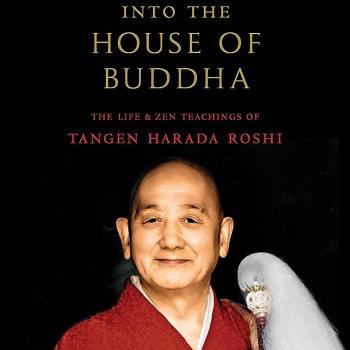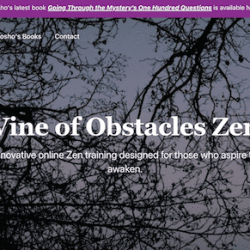“Truly experience the all-inclusive activity of life…,” says Bokusan in commenting on the firewood and ash simile of the Genjokoan. Reading the commentary of this 19th century Soto Zen teacher, what strikes me again and again is his insistence on realization. Somehow in the 20th century, much of Soto Zen seems to have taken a turn away from this emphasis.
That brings me to the Ten Ox-herding Pictures, a wisdom-development system that’s been around in various forms for about a thousand years. Apparently, Dogen wasn’t into it, although I can’t find his negative reference just now. Anyway, Dogen’s dead … and (despite his brilliance and despite that I’ve argued that his Shobogenzo and Eiheikoroku ought to be regarded as “source texts” for Soto Zen) we are free to use non-Dogen elements in this teaching and practice of non-self.
To agree completely is to be unfaithful.
Imho, the Oxen are important right now because they point to the possibility of practice, a possibility that often gets lost and forgotten in the course of study in our busy modern lives.
In what follows, I’ll present and comment on just the first couple (and very briefly introduce the rest) of ten frames. Daido, by the way, has a nice little book on these, Path of Enlightenment: Stages in the Spiritual Journey.
1. Searching for the Ox
Here’s the traditional verse for this stage:
When the truth is found to be lies and all the joys within you dies… When the garden flowers baby are dead yes and your mind is full of red… your eyes, I say your eyes may look like his but in your head baby I’m afraid you don’t know where it is… tears are running ah running down your breast and your friends baby they treat you like a guest don’t you want somebody to love don’t you need somebody to love
Okay, that isn’t the traditional verse and it really works best to hear Gracie Slick wail it out. Yes, I saw A Serious Man last night – a great portrait of Jewish samsara. Jefferson Airplane’s tune haunts the film and is also a great Searching for the Ox verse, especially “when all truth is found to be lies” includes our cultural myth that finding someone to love (or maybe Gracie was just thinking “have sex with” …) will somehow save you.
Sick of lies. Sick of our culture. Sick of our self. Where to turn? Somehow, maybe while reading about the dharma or watching Oprah or seeing the posters at the food co-op, we become aware that there’s another way and we set out to find it.
And what was very recently pretty simple – when I started looking Katagiri Roshi was the only Zen teacher for about 2,000 miles – first became the spiritual supermarket and is now a spiritual mega-mall. In this context, finding a true path is no easy matter. And we’ve got this heavy cultural load of multi-tasking that makes it more difficult to stick with one thing for a long time.
Mysteriously, some of us stumble upon an affinity with a tradition and a lineage that point to the most important thing.
2. Finding Traces of the Ox
We see the traces of the Ox when we hear the Heart Sutra and our heart stops … for a moment. Or when we hear a dharma talk or read a Zen book and we cry out to ourselves, “This is what I’ve always believed.”
At this stage, the task is to develop some mastery for how the great mystery is to be sought within this imperfect human system. Finding Traces of the Ox refers to getting into a way of seeking. We learn the language and the practices of a tradition, begin to develop a relationship with a teacher, begin to have an intellectual understanding of the teaching, etc.
This stage is fraught with peril.
It is so easy to lose touch with what brought us to the dharma to begin with. Probably it wasn’t a need for belonging. Looking at the Ox-Herding pictures this morning, I’m struck by how the person is alone, searching for and taming the Ox, until the Ox is forgotten way up there in the seventh stage.
However, a shift often takes place so that the original waft of Way Seeking Heart just blows hot air – dogma runs over the dharma. Zen students cut their hair short and wear dark-colored cloths. Zen lingo spews from the mouth. And because the person looks and sounds so Zen (in whatever locale-specific way that’s normed), about this time, the second-stage student gets recruited to serve on this or that committee at the local Zen Center. Danger! You might wind up looking and sounding like a Zen student but having really lost your way.
It is important to do the work of this stage without getting so identified with “Zen the religion” that we forget that the raft is not the shore. This work culminates in a deep, personal cry, “What am I?” or in the Rumi poem I quoted in the webinar Saturday (see below) “What is life worth? If there is a God, come into me NOW!”
3. Glimpsing the Ox
.. and the ass of the ox at that in the thicket of our own views.
In some ways, this is the beginning of practice. Very important here to have a teacher who can point out that this glimpse – isolated, private mental experience – doesn’t satisfy our original true aspiration. We’re called to actualize our little glimpse of enlightenment, come hell or high water. Even to look into our own greed, anger, and ignorance from the perspective that’s been opened up through our glimpse of the Ox’s ass.
That’s the work of the next several stages.
There’s an interesting and very powerful shift in the Ox metaphor within this system. At the beginning the Ox represents true nature. In the middle stages, the Ox represents our own greed, anger and ignorance but still as some thing, something outside, something witnessed. Then the Ox disappears. Then the self disappears. Then the 10,000 things advance, confirming the selfless self.
Then we’re ready to begin anytime anywhere.











